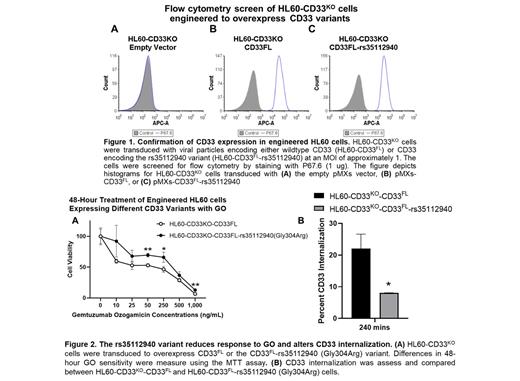Abstract
Background
CD33 is a myeloid-specific cell surface protein widely expressed on acute myeloid leukemia (AML) cells making it an excellent immunotherapeutic target. Current CD33-directed immunotherapeutic treatment strategies include gemtuzumab ozogamicin (GO), an antibody-drug conjugate (ADC) which was approved for the treatment AML in 2017 and has demonstrated promising results thus far. The mechanism of action of GO begins with recognition of CD33 by the antibody portion of GO, followed by internalization of the CD33-GO complex, and finally delivery of free calicheamicin molecules to the cell to induce cellular apoptosis. As such, modifications that impact these steps on any level presumably impact the response and overall efficacy of GO. Indeed, previous studies from our group have identified germline variations in CD33 that are associated with differences in CD33 structure, CD33 cell surface expression levels, and clinical outcomes in response to GO. Among these germline variations is rs35112940 (G>A; Arg304Gly), a missense polymorphism which is located in exon five of CD33 adjacent to the cytoplasmic immunoreceptor tyrosine-based inhibitory motif (ITIM) domain, a critical feature for CD33 internalization. While our previous work identified statistical associations between the A allele of rs35112940 and lower CD33 expression and reduced benefit from treatment using GO, these results are yet to be validated functionally. Additionally, it still remains unknown if the impact of the rs35112940 variation is due to reduced CD33 expression alone or if the rs35112940 variation also impacts CD33 internalization thereby modulating CD33 efficacy.
Methods
To functionally validate the effect of the rs35112940 variant, we used CRISPR/cas9 to knockout CD33 in HL60 cells and subsequently engineered the HL60-CD33 KO cells to express either wildtype CD33 (HL60-CD33 FL) or CD33 encoding the rs35112940 variant (HL60-CD33 FL-rs35112940). The engineered cells were then treated with GO for 48 hours to capture the impact of the rs35112940 variation on the efficacy of GO. To assess the impact of the rs35112940 variation on CD33 internalization, we performed a flow cytometry-based internalization assay using secondary antibodies to capture the remaining amounts of CD33 present on the cell surface after 4 hours allowing us to determine the internalization of CD33 over time.
Results
All engineered cells expressed CD33 with less than 1-log fold difference in median fluorescence intensity (MFI) (HL60-CD33 FL MFI vs HL60-CD33 FL-rs35112940 MFI: 22536 vs 24882, Figure 1) and thus we were able to characterize the impact of the rs35112940 variant independent of its impact on CD33 cell surface expression. After 48-hour treatment with 250 ng/mL of GO, we observed that HL60-CD33 FL-rs35112940 cells were more resistant to GO than HL60-CD33 FL cells (66.4% vs 46.5% cell viability, P = 0.02, Figure 2A). Similar results were observed at multiple concentrations of GO. Given the proximity of the rs35112940 loci to the ITIM domain of CD33, we hypothesized that the rs35112940 variation may impact CD33 internalization as well. In a flow cytometry-based internalization assay over a 4-hour window, we observed that that HL60-CD33 FL-rs35112940 cells had an approximate 10% reduction in CD33 internalization in comparison to HL60-CD33 FL cells (Figure 2B). Taken together these results provide insight into the effect of the rs35112940 variant on GO efficacy and CD33 biology, corroborating our previous findings, and support the use of CD33 polymorphisms to guide patient selection for treatment with GO.
No relevant conflicts of interest to declare.


